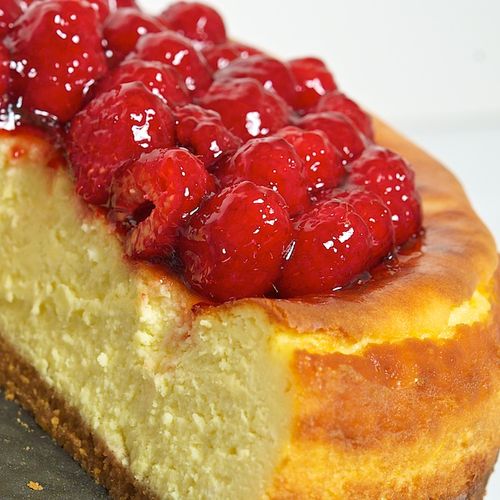
Photo: Oui Chef
Well I’m pleased to say – both of these problems can be easily fixed as they generally stem from the same issues. They say patience is a virtue and with cheesecake, it’s crucial.
Making the perfect baked cheesecake is all about low and slow.
Low and slow – low temperatures, low speed beating, slow combining of ingredients, slow baking, slow cooling.
Perfect baked cheesecake will not be hurried.
Make sure all of your ingredients are truly room temperature before you start – including your eggs. Your cream cheese should be very, very soft.
Don’t even think of putting your mixer on high speed. Always use low speed. Too fast/high will incorporate air to the mixture which will cause your cheesecake to rise while baking and then flop spectacularly when it cools. Not what you’re looking for.
Keep your oven temperature low – 140 to 150 degrees Celsius or 280-300 degrees Fahrenheit. Yes it will take a long time for your cheesecake to bake at this temperature, but it’s the best way to avoid cracked and sunken cheesecakes.
Use the baking time in your recipe as a guide only – you want your cheesecake to be set, but only just. Over baking is one of the main causes of cracking. The center of your cheesecake should still seem under baked and slightly wobbly.
When it gets to this point – turn off the oven and open the oven door (I usually stick a rolling pin in the door to stop it closing). The remaining oven heat will finish baking the cheesecake but, importantly, this allows the cheesecake to cool very slowly. Leave the cheesecake here until the oven is cold. Once cold, put it in the fridge until you’re ready for it.
Baking cheesecake in a water bath
Some bakers swear by the water bath technique, where the cheesecake pan is wrapped in aluminum foil and placed inside a lager pan containing approx two inches of boiling water. The idea is that water regulates the baking of the cheesecake, causing it to bake more evenly and slowly. The water also adds humidity to the oven and prevents the surface of the cheesecake drying out and cracking.
The truth is that you can bake a perfect cheesecake without a water bath.
But if you are having persistent cracking problems it might be worth trying this technique. Just make sure your cheesecake pan is wrapped very securely in the aluminum foil (with no holes). You don’t want water seeping into your pan as this will ruin your cheesecake more than any cracking will.
Is a cracked or sunken cheesecake the end of the world? Of course not. It will still taste delicious and with a bit of creative decorating no one will ever know. Pile your cheesecake high with berries or fruit, or cover it in chocolate curls and shavings. A thick chocolate ganache can work wonders too.
For some gorgeous cheesecake recipes, take a look at our Cheesecake Recipe Collection. Prepare to swoon with cheesecake desire.
Of course, if you’re making Japanese Cheesecake you want to ignore all of the above and pretty much do the complete opposite (apart from the slow cooling which prevents cracking). With Japanese cheesecake you want the air for the light and fluffy texture.


No comments yet.